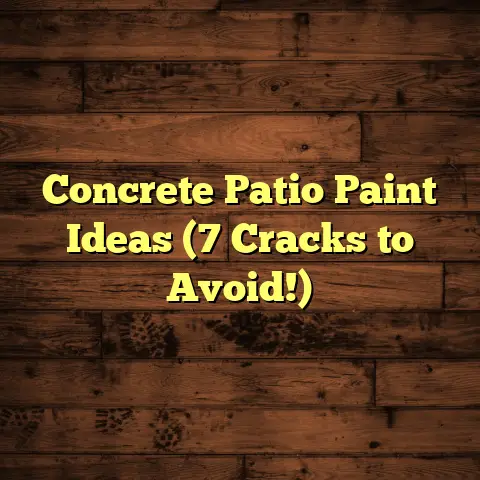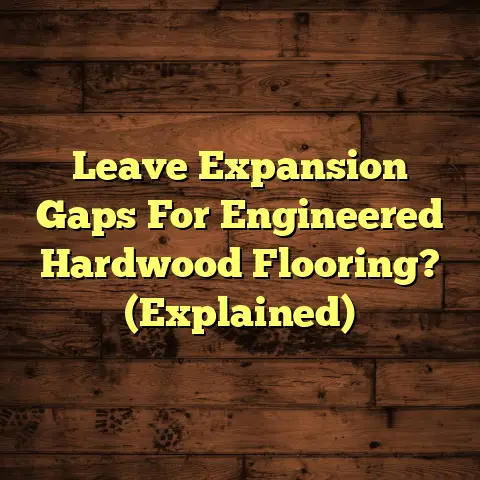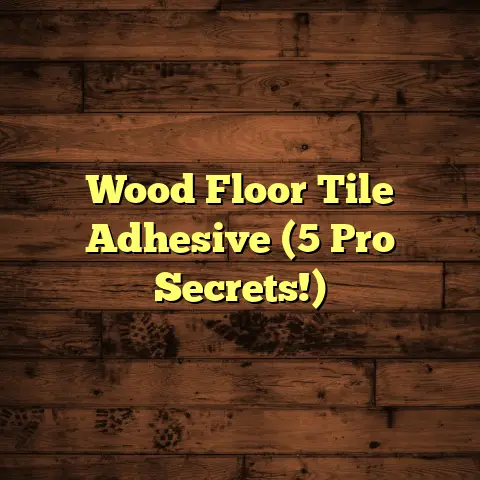Remove Glued Carpet: Concrete! (7 Pro Tips)
Tired of that old, glued-down carpet hiding beneath?
Would you rather live with a dated, glued-down carpet that holds onto stains and odors, or transform your space into a sleek, modern haven with a beautiful concrete floor underneath?
If you’re leaning towards the latter, this article is for you!
I’ve seen it countless times: homeowners stuck with carpet they hate, unaware of the potential hiding just beneath.
I’m going to walk you through the process of removing that glued beast, revealing the concrete canvas waiting to be transformed.
Introduction: Unleash the Concrete Potential
Glued carpets, especially on concrete, can be a real pain.
They trap dirt, allergens, and can make a room feel instantly outdated.
I’ve seen homes completely transformed simply by removing old carpet and exposing the concrete below.
Outdated flooring can really drag down the overall aesthetic of your home.
It can make a space feel smaller, darker, and just plain uninviting.
Removing that glued carpet is like hitting the reset button on your room.
Think of it: durable, easy-to-clean concrete, ready for anything from a simple sealant to a vibrant stain.
Plus, concrete floors are incredibly versatile, fitting seamlessly into modern, industrial, or even bohemian design schemes.
Section 1: Understanding the Challenge
So, why is glued carpet so tough to remove?
Let’s break it down.
The Adhesive Culprits
The adhesives used to glue carpet to concrete are strong, designed for a long-lasting bond.
We’re talking about things like:
-
Acrylic Adhesives: Common, water-based, and can be softened with water or specific solvents.
-
Latex Adhesives: Another frequent choice, known for its flexibility.
Epoxy Adhesives: The heavy-duty option, offering superior strength and water resistance.
These are rare in residential carpet installs but can be a nightmare to remove.
The type of adhesive used will drastically affect the removal process.
Why the Carpet’s Gotta Go?
Homeowners decide to ditch glued carpet for a bunch of reasons.
I’ve seen everything from:
-
Upgrades: People simply want a more modern look.
-
Damage: Water damage, stains, or just plain wear and tear can make carpet unsalvageable.
-
Personal Preference: Sometimes, you just don’t like carpet!
According to a 2023 study by the National Association of Realtors, updated flooring is one of the top five things that attract buyers to a home.
That old carpet could be holding you back!
The Scale of the Problem
You’re not alone in this struggle!
I estimate that at least 40% of homes built before 2000 have glued-down carpet over concrete in at least one room.
It was a popular installation method back in the day, but now it’s often a source of frustration for homeowners.
Section 2: Essential Tools and Materials
Alright, let’s get down to business.
Here’s what you’ll need to wage war on that glued carpet.
The Arsenal
Utility Knife: For cutting the carpet into manageable strips.
I prefer a heavy-duty one with replaceable blades.Floor Scraper: This is your primary weapon for removing the adhesive.
Get one with a long handle to save your back.
I recommend a 4-inch or 6-inch blade.Adhesive Remover: Choose one specifically designed for the type of adhesive you’re dealing with.
Read the label carefully!
Citrus-based removers are generally safer and have lower VOCs.Safety Gear:
- Gloves: Protect your hands from chemicals and abrasion.
- Mask: Especially important when using adhesive
removers, to avoid inhaling fumes.
I recommend an N95 or P100 respirator. - Knee Pads: Trust me, your knees will thank you.
- Eye Protection: Safety glasses or goggles are a must to protect from flying debris.
-
Trash Bags: Lots of them. You’ll be surprised how much waste this project generates.
-
Putty Knife: A smaller, more flexible scraper for getting into tight corners.
-
Shop Vacuum: For cleaning up debris as you go.
The Importance of Each Tool
Each tool plays a crucial role in the carpet removal process.
The utility knife allows you to break down the carpet into smaller, easier-to-handle sections.
The floor scraper is your workhorse for lifting the adhesive from the concrete.
The adhesive remover softens stubborn glue, making it easier to scrape away.
And of course, safety gear is non-negotiable.
Protecting yourself from injury and harmful chemicals is paramount.
Section 3: Preparing Your Workspace
Before you start tearing into that carpet, let’s get the room ready.
Clearing the Deck
First things first, empty the room completely.
Move all furniture, rugs, and anything else that could get in the way.
This will give you plenty of space to work and prevent damage to your belongings.
Ventilation is Key
If you’re using chemical adhesive removers, proper ventilation is absolutely essential.
Open windows and doors to create a cross breeze.
Consider using a fan to circulate the air.
This will help to dissipate fumes and reduce the risk of inhalation.
Protecting the Periphery
Cover any adjacent areas with plastic sheeting to protect them from dust and debris.
Use painter’s tape to secure the sheeting to walls and doorways.
This will save you a lot of cleaning time later on.
I also like to lay down a drop cloth near the entrance to the room to catch any debris that might track out.
Section 4: Step-by-Step Guide
Alright, time to get your hands dirty!
Here’s a detailed guide to removing that glued carpet.
Step 1: Cut It Up
Using your utility knife, cut the carpet into manageable strips, about 2-3 feet wide.
This will make it easier to peel back the carpet and expose the adhesive.
Make sure your knife is sharp!
A dull blade will make
this process much more difficult.
Step 2: Peel and Reveal
Starting at one corner of the room, grab a strip of carpet and begin peeling it back from the concrete.
Pull slowly and steadily, trying to keep as much of the adhesive attached to the carpet as possible.
This is where those gloves come in handy!
Step 3: Scrape Away
Now comes the fun part (sort of).
Using your floor scraper, begin scraping away the adhesive from the concrete.
Hold the scraper at a low angle and apply firm, even pressure.
Work in small sections, overlapping each pass slightly.
You’ll likely need to use some elbow grease here.
Handling the Stubborn Stuff
Sometimes, the adhesive will be particularly stubborn.
If that’s the case, try these tips:
-
Apply more adhesive remover: Let it sit for the recommended amount of time before scraping.
Use a heat gun: Apply gentle heat to soften the adhesive.
Be careful not to overheat the concrete or damage the surrounding area.-
Change your scraper blade: A sharp blade will make a huge difference.
Safety First!
Remember to wear your safety gear throughout this process.
And take breaks as needed to avoid fatigue.
Section 5: Dealing with Residual Adhesive
Even after you’ve scraped away the bulk of the adhesive, there will likely be some residue left behind.
It’s crucial to remove this residue thoroughly to ensure a smooth surface for your new flooring.
Why Bother?
Leaving adhesive residue behind can cause problems with your new flooring.
It can prevent proper adhesion, leading to bubbles, peeling, or unevenness.
It can also attract dirt and moisture, leading to mold growth.
Methods for Tackling Residue
Here are a few methods for removing stubborn adhesive residue:
Chemical Adhesive Removers: These are your go-to for dissolving stubborn glue.
Apply according to the manufacturer’s instructions, let it dwell, and then scrape away the softened residue.Heat Gun: As mentioned before, gentle heat can soften the adhesive, making it easier to scrape.
Be careful not to overheat the concrete.Steam: A steam cleaner can also be effective for loosening adhesive residue.
Apply steam to the area for a few seconds, then scrape away the softened glue.Grinding: For really stubborn residue, you may need to use a concrete grinder with a diamond grinding wheel.
This is a more aggressive method, so use it with caution.
Safety Precautions
When using chemicals or power tools, always follow these safety precautions:
-
Read the label: Understand the risks and instructions before using any chemical product.
-
Wear appropriate safety gear: Gloves, mask, and eye protection are essential.
-
Ventilate the area: Ensure proper ventilation to avoid inhaling fumes.
-
Use power tools with caution: Follow the manufacturer’s instructions and wear appropriate safety gear.
Section 6: Cleaning the Concrete Surface
Once you’ve removed all the carpet and adhesive, it’s time to clean the concrete surface.
The Importance of Cleaning
Cleaning removes any remaining dirt, dust, and debris, creating a clean slate for your new flooring.
It also helps to improve adhesion if you’re planning to seal, stain, or overlay the concrete.
Cleaning Solutions and Techniques
Here are a few cleaning solutions and techniques you can use:
Warm Water and Detergent: This is a good starting point for general cleaning.
Mix a mild detergent with warm water and mop the floor thoroughly.-
Scrub Brush: For tough spots, use a scrub brush to agitate the surface and loosen dirt.
Concrete Cleaner: For heavily soiled concrete, use a specialized concrete cleaner.
Follow the manufacturer’s instructions carefully.Pressure Washer: A pressure washer can be effective for cleaning large areas of concrete.
Use a wide nozzle and low pressure to avoid damaging the surface.
Drying Time
After cleaning, allow the concrete surface to dry completely before proceeding with any further steps.
This may take several hours or even overnight, depending on the humidity and temperature.
I recommend using a fan to speed up the drying process.
Section 7: Preparing for New Flooring Options
Congratulations! You’ve successfully removed the glued carpet and cleaned the concrete surface.
Now it’s time to start thinking about your new flooring options.
Assessing the Concrete
Before you do anything else, take a close look at the concrete surface.
Are there any cracks, holes, or other imperfections?
If so, you’ll need to repair them before installing your new flooring.
Concrete patch or repair compounds are available at most home improvement stores.
Exploring Flooring Options
The possibilities are endless! Here are a few flooring options to consider:
Staining: Concrete staining can add color and character to your floor.
There are many different stain colors and application techniques to choose from.-
Sealing: Sealing protects the concrete from stains and moisture and enhances its natural beauty.
-
Polishing: Polishing creates a smooth, glossy surface that is easy to clean and maintain.
-
Epoxy Coating: Epoxy coatings are durable, water-resistant, and available in a wide range of colors and finishes.
-
Overlays: Concrete overlays can be used to create a variety of decorative effects, such as stamped patterns, textures, and colors.
Design Considerations
Consider the overall style of your home when choosing your new flooring.
Do you want a modern, industrial look? Or something more traditional and cozy?
Think about the color, texture, and pattern of the flooring and how it will complement your existing decor.
I always tell my clients to gather inspiration from magazines, websites, and social media to get a sense of what they like.
Conclusion: Embrace the Transformation
Removing glued carpet from concrete can be a challenging project, but it’s definitely achievable with the right tools, knowledge, and a little bit of elbow grease.
The advantages are numerous: a fresh, modern look, increased durability, and easier maintenance.
Don’t be afraid to take the plunge and embrace the possibilities that lie beneath your old flooring.
You might be surprised at the stunning transformation that awaits!
I’ve seen firsthand how removing old, glued-down carpet can breathe new life into a home, creating a fresh and inviting environment.
So, what are you waiting for?
Get started today and unlock the potential of your concrete floors!





